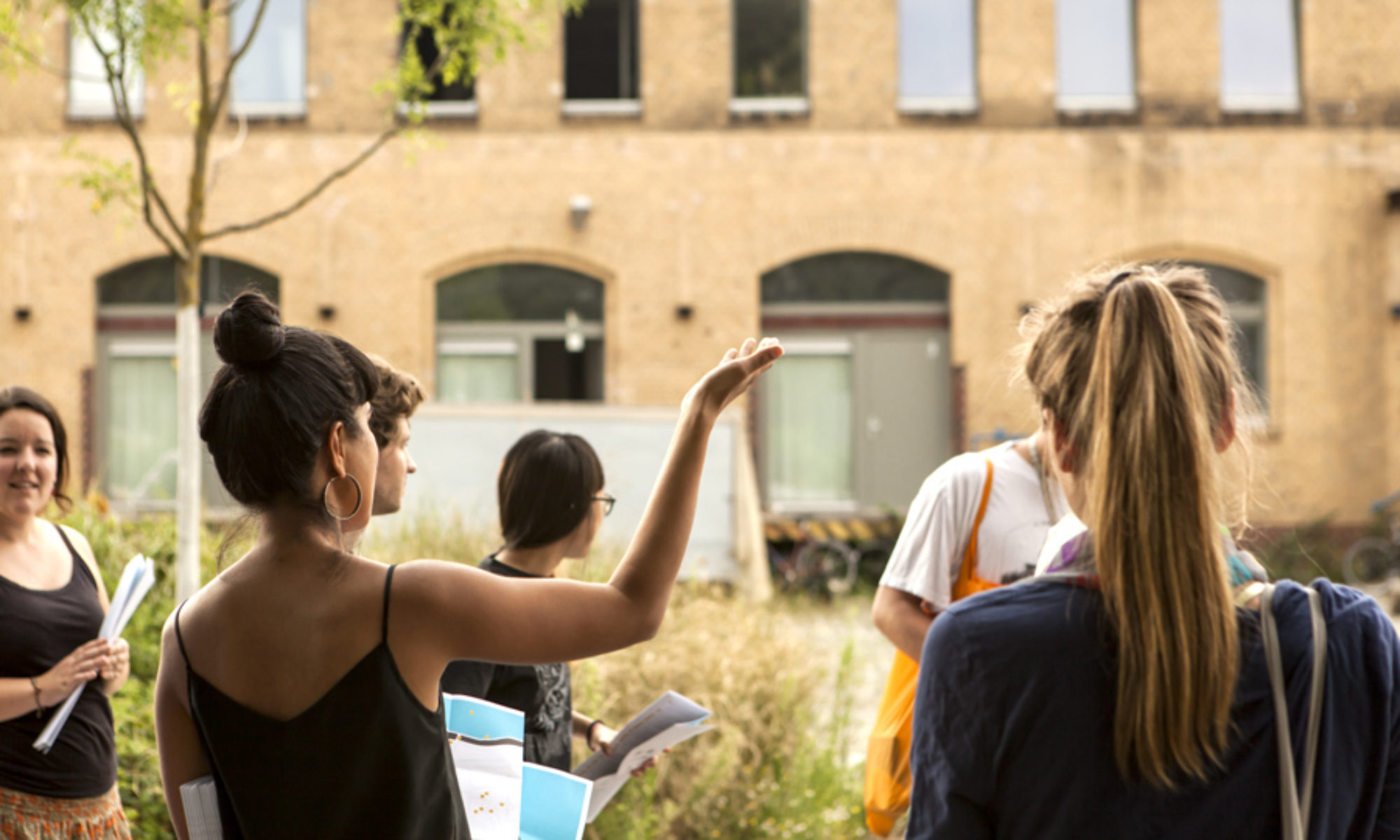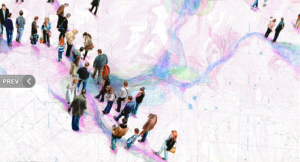
I was honoured to have been invited to speak to around seventy 18-24 year olds at the 2013 Rotary Youth Leadership Awards camp one month ago. The RYLA directors, Chris and Bill, asked me to speak about what I do and how I got to be doing it, linked to the themes of leadership and community. It was really valuable to take the time to reflect on these questions while preparing for the presentation, and I thought I’d upload a rough transcript of my presentation. It’s cheesy and earnest like it was meant to be.
I’d like to start by acknowledging the traditional owners of the land that we’re on, the Wurrundjeri people. I’d like to acknowledge their ongoing connection and relationship with this land, and I’d like to pay my respects to their elders, past and present.
I feel very honoured to be speaking with you all today. Chris and Bill ran through the program with me the other week and it looks like you’ve got an amazing week ahead of you. It’s nice to be able to be a part of it.
Have any of you heard of a human ecologist before? Can anyone guess what human ecology might involve? …Well, the name pretty much sums it up – it’s the study of the ecology of humans, or the study of our relationship with the ecosystems that we’re part of and dependent on… with a focus on how to make that relationship a healthy one for all involved.
I’m a human ecologist. And seeing as very few people know what a human ecologist is or what we do, it means that I get to do whatever I want. My projects and writings tend to focus on connections – our connections with each other, our connections with place (locally and within our wider ecology), and our connections with our selves. Society, soil and soul.
I’ve worked for various not-for-profit organisations here in Melbourne, in the UK and in Thailand, but my favourite patches of life have involved making up projects and being my own boss, so in the last few years I’ve set myself up to be able to do this.
These days I work independently, developing my own socially engaged art projects, as well as writing a few environmental articles, and consulting for other people’s projects. My days are pretty varied, which keeps me interested. Over the last month, for example, I’ve been wrapping pass the parcel packages for a participatory art project I’ve developed called In Passing. I’ll tell you a little about In Passing in a moment.

But, to go back in time a bit first, my previous work has been a more straight down the line approach to sustainable community development and sustainability research. I’ve worked with: the Moreland Energy Foundation in Melbourne coordinating creative projects to support residents and small business owners to reduce their energy consumption; the Transition Network in the UK (who coordinate Transition Town initiatives across the world… these are essentially communities that are taking steps to make their town or city more sustainable and more resilient to environmental and resource challenges); with CERES community environment park looking at the food miles associated with our dietary habits; with VEIL, or the Victorian Eco-Innovations Lab, looking at how resilient Victoria’s food system is to a number of key environmental challenges; with a women and environment organisation in Thailand, looking at how rural and indigenous women are impacted by global trade in food and agriculture…
Most of this work has been really rewarding, but I’ve often felt a little uneasy about an underlying assumption that some NGOs and activists seem to have, where they think that they have the answers and if only the masses would listen to them then we’d all be better off. The intention is good but at the back of my mind it seemed to carry a sense of arrogance to me.
I couldn’t pinpoint why until five years ago, while I was living in the UK. I was commissioned by a publisher and an organisation called the Transition Network, which I mentioned before, to turn my Masters thesis into a book. My thesis was called ‘future-proofing our cities: resilience, reconnection and relocalisation’. The manuscript for the book still lies comatose in my laptop 5 years on… BUT while I was doing research for the book and collecting stories from around the world about how communities in cities are taking it into their own hands to make their neighbourhoods more resilient, I noticed a confusing pattern… that every single project that I was really inspired by and wanted to write about was artist-initiated… they were art projects.
I had never paid that much attention to participatory art, but I realised that what drew me to these projects is that they all seemed to be asking questions, rather than trying to answer them.
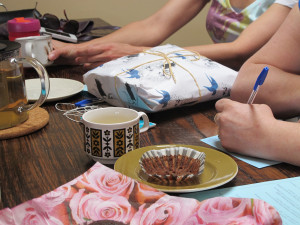
And this is what I do now. I use participatory art as a medium for exploring socially and culturally significant issues. I ask questions of strangers in ways that encourage them to connect to their own stories, to their own wisdom and values, and to their selves. Through an artistic inquiry approach, I create opportunities for people to share their own ideas and to work together on their own solutions to problems that we’re all aware of to some degree.
I’m still finding my way with it, but I really believe that this is an important thing to do, particularly in this day and age when we’re all becoming increasingly wary of the spin coming from our political leaders and the media. I think it’s really important that we ask questions that encourage people to pause and step into their own wisdom to find answers.
…Which brings me back to my pass-the-parcel project, In Passing. It’s a participatory art project that has brought groups of women together in 18 lounge rooms across the suburb of Brunswick, in Melbourne’s inner north, to share our thoughts and experiences of gender, power and public space… through games of pass the parcel.
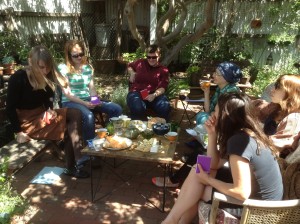
Last year when the news struck that the ABC journalist Gill Meagher was raped and murdered just off my street in Brunswick I became scared, but after that, I became really frustrated with the social commentary on the issue. I understand that the issue of violent attacks against women will take centre stage in the media at times like that, but I wanted people to make the connection to the constant undercurrent of gendered power plays that colour our everyday experiences of public spaces. From the lewd comments from men in passing cars, to offensive graffiti that lines our alleyways, to the omnipresent sexualised images of women plastered on bus shelters, these occurrences and images have subtle but constant effects on our psychology. While these examples are considered too trivial to feature in the media or social commentary, they sit on the same spectrum as the more physical and violent acts against women in public space. I wanted to point a finger at these issues and I wanted to find out how they may affect how women feel on our streets everyday.
So over the course of a year I developed In Passing. In essence, the project involved creating a pass-the-parcel game in which each layer of the parcel is an activity or conversation starter about a different facet of public space. 18 women from across Brunswick put their hands up to host a game and each of them invited around 8 women from their immediate neighbourhood to their game. The pass-the-parcel structure allowed the women, sometimes strangers to each other, an opportunity to share their thoughts on serious issues in a light-hearted, non-threatening and constructive way. The layer activities involved things like…
- examining our own responses to lewd comments and making Comeback Cards together… cards that they could carry around in their wallets for next time,
- studying the art of penis graffiti… why do guys do that?? and experimenting with vagina graffiti and seeing if that feels like a constructive thing to do… or whether it feels like contributing to the sexualisation of women’s bodies… and discussing why penis graffiti and vagina graffiti may provoke different reactions,
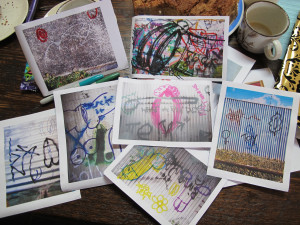
Questioning penis graffiti / practicing vagina graffiti - there was a layer called ‘give us a smile, love’, in which they showed each other their smiles of discomfort and discussed why women are said to be more likely than men to smile when we’re uncomfortable with a situation…
- giving voice to objectified billboard models… I provided them with weather-proof speech bubble stickers and photos of ads from around the suburb,
- considering women’s physical use of space by getting everyone to FREEZE and notice how much space they’re taking up and then thinking of the first man that comes to mind and imagining how they’d be sitting or standing or speaking at that moment, and so on.
All the activities were phrased as questions… asking what the participants think about these issues…
The project is wrapping up this weekend with a picnic for all 150 women participants in a park in Brunswick where they can continue the conversations and plot about ways that they can address the issues that have come up.
Once In Passing ties up, I’ll be starting to prepare for my next project, called Urban Myths, a story-mapping project which I’ll be doing while on a 4-month residency in Berlin from early next year. In my Masters thesis, I explored the importance of connection to place. Through Urban Myths, I’ll be looking at how people actually connect with place. The plan is to put together a map or a guidebook to Berlin and the key to the map, instead of ‘restaurant’, ‘information’, ‘public toilets’ etc., will be things like a place for a secret kiss; a place to reflect; a place to have a difficult conversation; a place to plot the revolution; a place to not be seen, and so on. I’ll be asking strangers to take me to these places and to tell me a story of their connection to that place.
One of the great things about managing your own projects is the freedom to adapt the project to take up exciting opportunities as they emerge. For instance, I’ve been approached by a London-based media artist who develops mobile apps and web-based interactive documentary, who wants to work on Urban Myths with me. And I’m really excited about that because I’d already thought that it would work well to have some sort of interactive mobile technology to enable people to take themselves on self-guided tours and contribute their own stories, but I have no idea about that stuff myself. And it will be interesting (and challenging in new ways) to work with someone else on the project. We’re also looking to adapt the project to other urban contexts as we think it will be a great asset for a city. I’m really intrigued about what this project will look like in a year’s time.
To go back in time again, in year 12 I studied Maths 1, Maths 2, Physics, Chemistry and Indonesian. If you were to tell my younger self that fifteen years later I would be doing an artist residency in Berlin after spending a month wrapping pass the parcel packages for a living, I would have thought you were crazy. And my dad would have had a heart attack. It’s been a windy road to this point, involving studying a few years of biomedical science, a few years of behavioural science, honours in anthropology and the human ecology masters in Glasgow, with a few years of time out in between all that. The path has been wiggly and at times frustrating when I’ve wished I could just put a box around myself and declare something like ‘I’m an architect’. But with the years, I’ve learnt to value the windy path for the amazing scenery it’s provided.
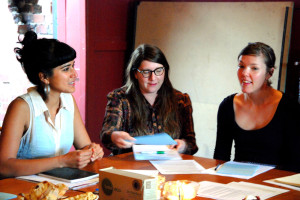
This relates to an approach I try to design into my projects… that each step of the process should not just a means to an end, but should be just as valuable (if not more valuable) than any intended outcome. So the process of the training up the pass-the-parcel hosts in In Passing was intended to be just was rewarding and fun for all involved (including me) as the games themselves… and much more valuable than the evaluation and recommendations report which my funders are keen to see. Valuing the process is really important to me because in some ways, that’s the only thing that’s a given. The outcomes of participatory community projects will nearly always be different to what was initially intended or expected.
I’m still having to remind myself to take that approach to everyday life though. That the process of doing all this, all the projects, all the tangents I’ve taken myself on, all the little steps along way of this life bizo is actually what we should be valuing, and not the end outcome of being labeled ‘successful’.
So to tie this all together with the theme of leadership… My dad, when I was younger, often talked about how he wanted to see me as a leader. I tried to picture myself speaking from a podium to crowds of roaring fans, which was an intimidating thought as I was (and still am) terrified of public speaking. I now realise that that’s how he would have done ‘leadership’, that singular person on the top of the podium and everyone else below. That’s a hierarchical value system that I myself don’t subscribe to.
We live in a celebrity-focused culture and it’s easy to point to the people in the limelight as ‘the leaders’, but we all contribute to our society in some way or another, from the garbos to the politicians to the activists in treesits to the uni lecturers. Just because some people enjoy the limelight or can work it better than others doesn’t necessarily make them the people we need to be listening to more than others. Through my projects, I try to bring out the voices of those others.
I think of leadership as being an individual approach or mindset. I think I myself take a ‘leadership from the shadows’ approach… for better or for worse most of the people impacted on by my projects will have no idea who I am. But I think we all need to find our own approach to leadership. You may be lucky enough to have a good sense of your own approach by the end of this week, or if you’re like me it may take a little while to work out… as I said, paths can be windy.
But I think the way that I’ve been able to find my own approach to all this is to spend some time getting to know myself, learning what my values are and then holding them close, learning what I do and don’t enjoy doing, what my passions are, and learning to listen to what my gut is telling me… and then trying to listen closer because my gut has a tendency to mumble. Learning all this and then learning again because humans aren’t static… we change our minds, and that’s totally okay. So, most important of all, I think, is to just really enjoy each step of the windy journey.
